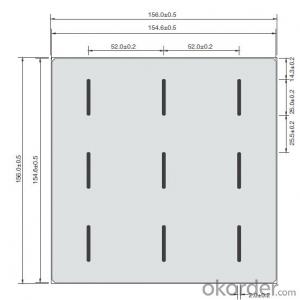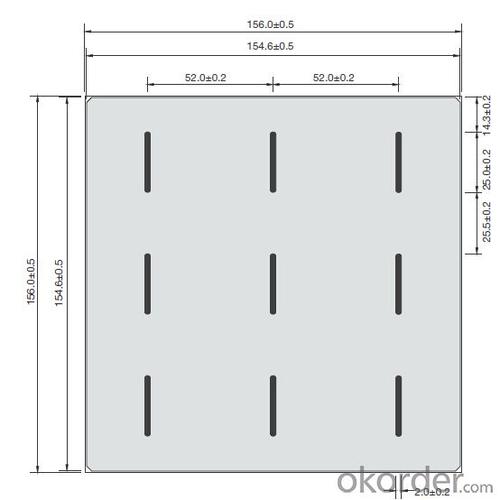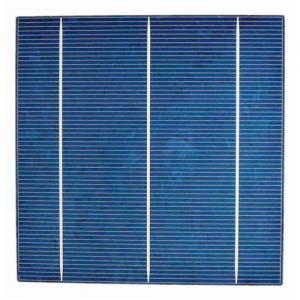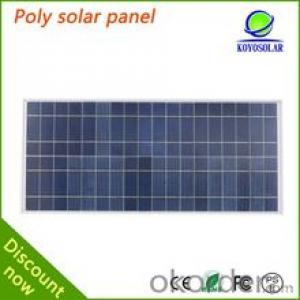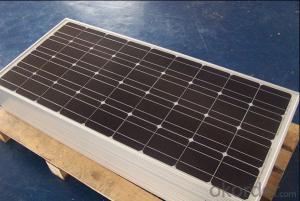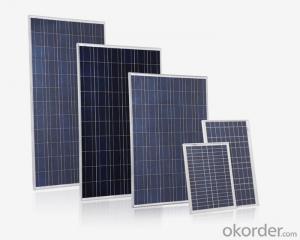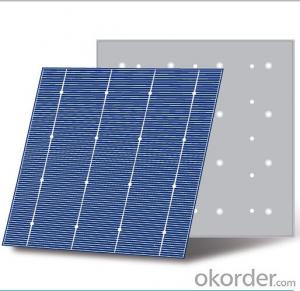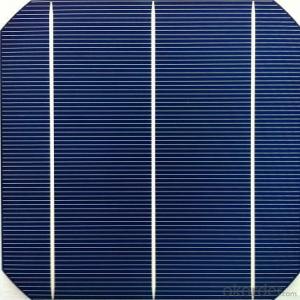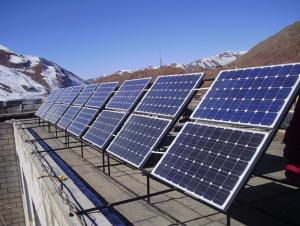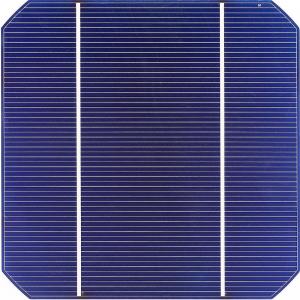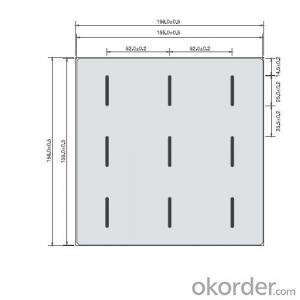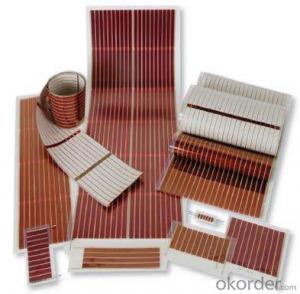Atj Solar Cells Polycrystal Solar Cell Jac P6RF-3 (Cypress2)
- Loading Port:
- China main port
- Payment Terms:
- TT or LC
- Min Order Qty:
- 360 watt
- Supply Capability:
- 100000 watt/month
OKorder Service Pledge
OKorder Financial Service
You Might Also Like
JACP6RF-3 3BB MULTICRYSTALLINE SILICON SOLAR CELL
JA solar's high effciency poly cell, manufacturing modules with more than 260W(6x10)and 310W(6x12)power putput becomes easier than ever.
Futures:
Format:156mmx156mm±0.5mm
thickness:210um±30um
Front:1.4mm bus bar(silver).blue anti-reflecting coating(silicon nitride)
back:2mm wide solding pads(silver)backsurface field(aluminum)
Data sheet
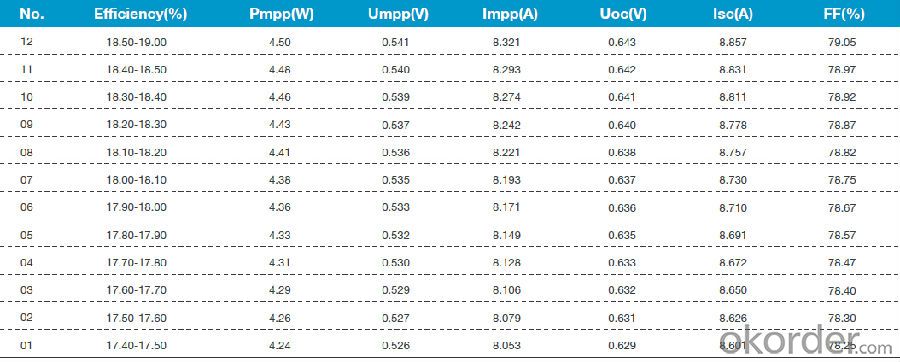
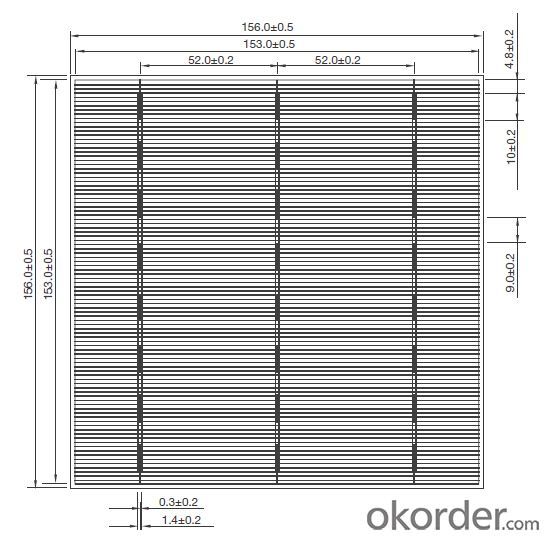
FAQ
We have organized several common questions for our clients,may help you sincerely:
①How about your company?
CNBM Solar photovoltaic (PV) Panel has various wattage from 1.5W to 315W to meet the demand of every customer. It is the optimal choice for both on-grid and off-grid power systems. CNBM Solar panel offers high performance of power warranty and good after sale service, we have professional people to reply your problem anytime.
CNBM International Corporation's products including Monocrystalline Solar Panel, Polycrystalline Solar Panel have received and enjoyed famous reputation in many countries and regions in the world .As a solar panel supplier in China, we strive to provide our customers with excellent service, superior products and unmatched value.
②How to guarantee the quality of the products?
CNBM Solar performance guarantees for 25 years
• 12 years guarantee for workmanship
• Timeliness of delivery
• Quality Products certified (TÜV, UL, CE, ISO)
③How long can we receive the product after purchase?
In the purchase of product within three working days, We will arrange the factory delivery as soon as possible. The pecific time of receiving is related to the state and position of customers.Commonly 7 to 10 working days can be served.
- Q: How do solar cells perform in areas with high levels of air pollutants?
- Solar cells can be negatively affected by high levels of air pollutants. The pollutants, such as smog and particulate matter, can reduce the amount of sunlight reaching the solar cells and lead to a decrease in their efficiency. Additionally, pollutants can accumulate on the surface of the solar panels, further reducing their performance. Regular cleaning and maintenance of the solar cells can mitigate some of these effects, but in areas with persistently high levels of air pollutants, the overall performance of solar cells may be compromised.
- Q: What is the role of disconnect switches in solar cell systems?
- Disconnect switches in solar cell systems serve as a crucial safety measure by providing a means to isolate the solar panels from the electrical grid. They allow for the safe maintenance, repair, or replacement of solar components without the risk of electrical shock or damage. Additionally, disconnect switches enable efficient troubleshooting and troubleshooting of solar systems by allowing technicians to isolate specific sections of the system for inspection or repair.
- Q: How much energy can a solar cell generate?
- The amount of energy a solar cell can generate depends on various factors such as its size, efficiency, and the amount of sunlight it receives. On average, a solar cell can generate anywhere from a few watts to several hundred watts of power.
- Q: Can solar cells be used for powering outdoor surveillance systems?
- Yes, solar cells can be used for powering outdoor surveillance systems. Solar cells convert sunlight into electricity, making them an ideal and sustainable power source for outdoor surveillance systems that require continuous operation. By harnessing solar energy, these systems can operate independently without the need for a grid connection or frequent battery replacements. Additionally, solar-powered surveillance systems are environmentally friendly and cost-effective in the long run.
- Q: Can solar cells be used to power off-grid cabins or homes?
- Yes, solar cells can definitely be used to power off-grid cabins or homes. Solar panels can convert sunlight into electricity, which can then be stored in batteries for use during the night or when the sun is not shining. This renewable energy source provides a sustainable and reliable power solution for off-grid living, reducing dependence on traditional energy sources.
- Q: Can solar cells be used for powering amusement parks?
- Yes, solar cells can be used for powering amusement parks. Solar energy can be harnessed and converted into electricity, which can then be used to power various rides, attractions, and facilities within the park. By utilizing solar cells, amusement parks can reduce their reliance on traditional energy sources and reduce their carbon footprint.
- Q: What is the effect of wind on solar cell performance?
- The effect of wind on solar cell performance can be both positive and negative. On one hand, wind can help cool the solar cells, preventing overheating and improving their overall efficiency. Additionally, wind can help clean the surface of the solar panels, removing dust and debris that may obstruct sunlight and reduce energy production. On the other hand, strong winds can create vibrations and mechanical stress on the solar panels, potentially damaging their structure or causing misalignment. Therefore, while some wind is beneficial for solar cell performance, excessive or turbulent wind conditions may have a detrimental impact.
- Q: Whether the solar cell is light can produce electricity
- Photoelectric effect of the work of thin film solar cells as the mainstream, and the implementation of photochemical effects of solar cells is still in the embryonic stage.
- Q: Can solar cells be used for powering airports?
- Yes, solar cells can be used for powering airports. Solar energy is a sustainable and renewable source of power, and airports have large areas of open space that can be utilized for installing solar panels. By harnessing the power of the sun, airports can reduce their reliance on non-renewable energy sources, lower their carbon footprint, and potentially save on energy costs in the long run. Additionally, solar power can also be stored in batteries for use during non-sunny periods or at night, ensuring a continuous power supply for critical airport operations.
- Q: How does a solar cell raise industrial efficiency?
- December 2014, the world record for solar cell efficiency at 46% was achieved.
Send your message to us
Atj Solar Cells Polycrystal Solar Cell Jac P6RF-3 (Cypress2)
- Loading Port:
- China main port
- Payment Terms:
- TT or LC
- Min Order Qty:
- 360 watt
- Supply Capability:
- 100000 watt/month
OKorder Service Pledge
OKorder Financial Service
Similar products
Hot products
Hot Searches
Related keywords
